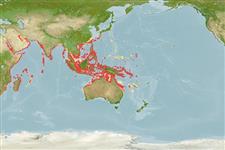分類 / Names
俗名 | 同種異名 | Catalog of Fishes(屬, 種) | ITIS | CoL | WoRMS | Cloffa
Teleostei >
Eupercaria/misc (Various families in series Eupercaria)
鱸形目 (Various families in series Eupercaria) >
Caesionidae (Fusiliers)
烏尾鮗科 (Fusiliers) > Caesioninae
Etymology: Caesio: Latin, caesius, bluish-grey, 1835; it is the same name given to the silvery metal (Cs) (Ref. 45335).
More on author: Cuvier.
Environment: milieu / climate zone / depth range / distribution range
生態學
海洋 礁區魚類; 非遷移的; 深度上下限 0 - 50 m (Ref. 402). 熱帶; 31°N - 28°S, 32°E - 167°E (Ref. 402)
Indo-West Pacific: Red Sea, Persian Gulf and East Africa to the Solomon Islands, north to southern Japan.
印度-西太平洋: 紅海 , 波斯灣而且東非到索羅門群島, 北至日本南部。
大小 / 重量 / 年齡
Maturity: Lm ? range ? - ? cm
Max length : 40.0 cm TL 雄魚/尚未辨別雌雄; (Ref. 402)
背棘 (總數): 10; 背的軟條 (總數): 13-15; 臀棘 3; 臀鰭軟條: 10 - 11. This species is distinguished by the following characters: a single postmaxillary process; D X, usually 14 soft rays; A III, usually 11soft rays; supratemporal band of scales generally interrupted at dorsal midline by a narrow scaleless zone; lateral line scales modally 49; scales above lateral line to dorsal -fin origin 7-10 (modally 8), below lateral line to anal-fin origin 14-19; predorsal scales 20-26; greatest body depth 2.2-3.1 in SL, head length 2.7-3.4 in SL; colour of body bluish, belly paler than upper sides; tips of caudal fin lobes, axil of pectoral fins, and upper base of pectoral fins black; caudal fin blue (except in juveniles where caudal fin and portions of caudal peduncle often yellow); pectoral, pelvic, and anal fins white to pale blue (pink or reddish after death); dorsal fin bluish (Ref. 68703, 90102).
藍色的身體, 腹側灰白的; 尾葉頂端,葉腋與胸鰭的上基底黑色。 稚魚有黃色的尾部與黑色的頂端。 在頰上的 4-5 鱗片; 18-25個前背的鱗片; 覆有鱗片的背鰭與臀鰭。 上柄的鱗片列通常 10 或 11(9-13); 下柄的鱗片列通常 14 或 15.(13-15) 鱗片的前期暫時條紋被在背部中線的一個細無鱗片的區域中斷。 對於 Baudelot 的結帶的附著的基枕骨突起不存在。 後顎的突起單個; 顎骨的後端鈍的。
Adults are found in coastal areas, mainly on or near coral reefs (Ref. 30573). They are more common along steep seaward reefs than in lagoons (Ref. 9710). They form large aggregations in midwater on upper edge of steep slopes and around patch reefs, often with other fusiliers (Ref. 90102). They feed on zooplankton. Are oviparous, with numerous, small pelagic eggs (Ref. 402).
發現於沿岸區域,主要在珊瑚礁上面或附近了。 (參考文獻 30573) 更普遍沿著陡峭的臨海礁石超過在潟湖中.(參考文獻 9710) 在中層水域中形成魚群並且吃浮游動物。 卵生的, 有很多的, 小型大洋性魚類卵.(參考文獻 402)
Life cycle and mating behavior
成熟度 | 繁殖 | 產卵場 | 卵 | 孕卵數 | 仔魚
印度-西太平洋: 紅海 , 波斯灣而且東非到索羅門群島, 北至日本南部。
Carpenter, K.E., 1987. Revision of the Indo-Pacific fish family Caesionidae (Lutjanoidea), with descriptions of five new species. Indo-Pac. Fish. (15):56 p. (Ref. 1723)
人類使用
Warning: mysqli::__construct(): (HY000/1040): Too many connections in /var/www/html/includes/func_getlabel.php on line 46
Can't connect to MySQL database (fbapp). Errorcode: Too many connections
